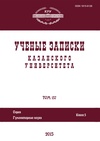Разграничение семантически близких глаголов: потенциал квантитативных методов
Differentiation of Semantically Close Verbs: The Potential of Quantitative Methods
Author(s): L. GuoSubject(s): Foreign languages learning, Lexis, Semantics, Pragmatics, Eastern Slavic Languages
Published by: Казанский (Приволжский) федеральный университет
Keywords: deictic verb; synonyms; quantitative analysis; quantitative methods; associative dictionary; language corpus; frequency;
Summary/Abstract: The paper is devoted to the study of the Russian deictic verbs oshchushchat’ (‘to sense’) and chuvstvovat’ (‘to feel’), which are similar in meaning and peculiarities of use in speech. The purpose of the study is their functional-semantic differentiation due to the importance of these synonymous lexemes for the verbalization of a person’s inner state. Since attempts of such a differentiation between these words from the perspective of traditional approaches do not bring conclusive results, we have compared them using quantitative methods, involving materials from associative dictionaries and very large language corpora. Based on data from the associative dictionaries, we have specified the notions of the paradigmatic and syntagmatic features of the compared verbs. The results of the quantitative analysis of word associations in the dictionary show a lower relevance of the verb oshchushchat’ for the linguistic consciousness of the native speakers of the Russian language in contrast with the verb chuvstvovat’ (106 reactions and 542 reactions, respectively); the verb chuvstvovat’ is characterized by more complex and rich paradigmatic and syntagmatic associations than the verb oshchushchat’. With the help of the language corpora, we have compared the indicators of the frequency of use of these synonyms in speech. The comparative analysis of the graphs constructed in the corpora with chronological distribution of the frequencies of use of word forms of the analyzed verbs suggests that the frequency of all the word forms of the lexeme chuvstvovat’ is higher than that of the corresponding word forms of the lexeme oshchushchat’ throughout almost the whole analyzed chronological section. Thus, the study quantitatively confirms the conclusion about a larger semantic volume of the verb chuvstvovat’, and defines the functional-semantic specificity of these words: the word chuvstvovat’ is most actively used when describing emotional states, and the verb oshchushchat’ is preferred in specifying objects of sensory perception. The present research demonstrates a new approach to the problem of the delimitation of synonyms, which may be of interest both to lexicologists and to specialists in the field of Russian as a foreign language.
Journal: Ученые записки Казанского университета. Серия Гуманитарные науки
- Issue Year: 160/2018
- Issue No: 5
- Page Range: 1176-1192
- Page Count: 17
- Language: Russian

